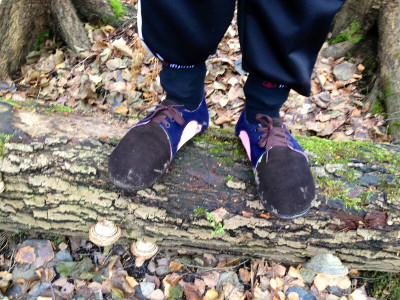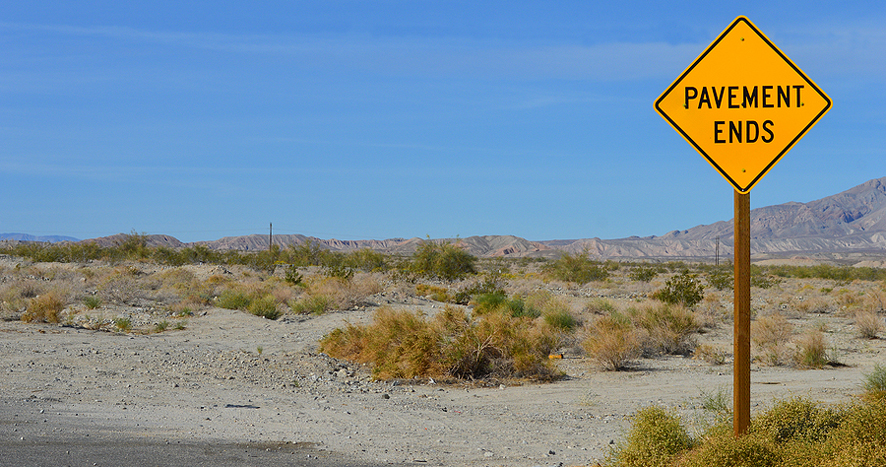Should Trail Shoes Be Thicker Than Street Shoes? Maybe Not...
Do you wear different shoes for walking on streets than you do for walking on trails? Do you find your trail shoes are more rigid and bulky? If so, then you're not alone.
Common sense says that trails require bigger, sturdier shoes. After all, there's a whole world of twigs and rocks out there that can damage your feet and you probably want protection from them. And after spending most of the day on surfaces that are smooth and flat, how would it feel to suddenly step on a sharp rock or uneven ground? Many people believe soles should be thick and tough to block those sensations, and that the structure of the shoe should brace the ankle in an upright position. Sometimes it seems as though the whole idea of stepping on a trail implies the need for shoes that are thick, rigid and impenetrable.
The growing interest in minimalist footwear and natural foot function has shed new light on this idea. After all, our ancestors spent a lot of time on unpaved surfaces, and bulky shoes were not an option for them.
An article by one of our favorite foot experts, Dr. Ray McClanahan, DPM, recently caught our attention. Co-written with Glenn Ingram, Jr., ND, and originally published in Walkabout Magazine, the article explores the different ways our bodies respond to walking on trails as opposed to walking on paved surfaces. Instead of recommending more supportive shoes for the rougher, unpredictable surfaces, McClanahan and Ingram suggest the opposite: less shoe is better, especially on trails.

Photo courtesy of Mikko from Helsinki, Finland
The explanation is quite simple. Walking on a flat paved surface uses the same muscles the same way for every step. Your body quickly learns how to do this, the range of motion is not challenging and there are little, if any, surprises concerning what you step upon.
On a trail, however, everything changes. Take a step off-road and your feet are now twisting every which way as they land on varied surfaces of rocks, twigs and uneven ground. This information is sent to your brain, which is then challenged to keep your body upright. At this time, it is very important for your feet to have a wide range of natural movement to adapt to surface changes. Rigid footwear not only blocks signals your feet may receive from the ground, but it can also restrict the range of motion in your feet and ankles. By inhibiting your natural foot function, you may be missing out on an opportunity to strengthen your feet while increasing the chance of injury.
For trails, the good doctors say barefoot is best, although people who have not been raised barefoot are recommended to find flexible barefoot-like shoes that allow their feet to bend and stretch naturally. And just like with minimalist running, anyone accustomed to sturdy, conventional shoes is advised to transition slowly to prevent injury; if you haven't used your muscles in this way before then they need time to strengthen and adapt.
Of course, trails do require certain needs. Most people will want some protection from those twigs and sharp rocks, and shoes that lack traction will invite slipping on loose or wet surfaces. The trick is to find shoes that have these features without restricting foot movement or weighing you down.
See our recommended Softstar shoes for hiking and trail running
We're happy to share with you the original article, which includes the docs' specifications for qualities to look for in a good trail-walking shoe:
Trail Walking Footwear
(as printed in Walkabout Magazine, Issue 24)
By Ray McClanahan, DPM and Glenn Ingram, Jr., ND
Walking on blacktop or concrete is a generally predictable experience, as far as the foot and ankle are concerned. Since these surfaces are mostly flat, the numerous joints in the foot and ankle become aware of moving within limited ranges of motion.
However, the foot and ankle undergo a different, less predictable experience the moment a walker decides to go off-road. Here, these same body parts will be called upon to keep the walker upright and moving forward while simultaneously adapting to ground surfaces that at one moment will require large amounts of pronation, and in the next step require large amounts of supination.
Here is where we believe a problem exists. Many walkers are going off-road in their street shoes. And we don’t mean their dress shoes. They are often going off-road in footwear that is holding their foot in a manner that does not allow the many joints of the foot to spread out and adapt to an ever-changing ground structure.
Experiencing the full capabilities of the foot and ankle adapting to non-linear surfaces takes practice and time. It also requires wearing no footwear, or choosing footwear that does not restrict foot and ankle motion.
Unless you have grown up completely barefoot — which we are fairly certain most of you have not — then we recommend the latter. The challenge is finding appropriate shoes. Many footwear companies are capitalizing on the walking boom and making trail versions of their urban walking shoes.
The problem is that instead of making shoes that are more flexible and foot-shaped, they are making them more stiff, sturdy, and over-designed.
Off-Road Footwear Should Offer the Following:
- Protection: Ideally this should involve a covering that goes over the entire foot and is snug over the ankle to keep rocks, twigs, and other trail debris from getting into the shoe.
- Traction: Soles that are smooth will be dangerous on loose and wet surfaces. A contoured sole with ridges and grooves will generally help provide better traction. The problem here is that these materials add extra weight, which is undesirable.
- Lightweight: Footwear that is light allows the walker to respond quicker to a changing ground surface.
- Flexibility: The closer a walking shoe is to a moccasin or a slipper, the more likely that shoe’s design will allow the joints of the foot and ankle to adapt to the trail surface. Most walking shoes currently available are not flexible.
- Foot-Shaped: There are three features built into footwear that stray from the natural foot shape, and they should be avoided:
- Heel Elevation: Soles should be completely flat.
- Toespring: The ends of the toes should be flat and level with the ball of the foot.
- Tapered Toe Boxes: The space allotted to the ends of the toes should be wider than the ball of the foot.
See our recommended Softstar shoes for hiking and trail running
 About Dr. Ray McClanahan: Dr. Ray's practice, Northwest Foot & Ankle in Portland, Oregon, allows him to care for those who find their highest joy when in motion. In his 17 years as a podiatrist, he has learned that most foot problems can be corrected by restoring natural foot function. He is also the inventor of Correct Toes, silicone toe spacers. His professional goal is to provide quality natural foot health services with an emphasis on sports medicine, preventative and conservative options as well as education on proper footwear. About Dr. Ray McClanahan: Dr. Ray's practice, Northwest Foot & Ankle in Portland, Oregon, allows him to care for those who find their highest joy when in motion. In his 17 years as a podiatrist, he has learned that most foot problems can be corrected by restoring natural foot function. He is also the inventor of Correct Toes, silicone toe spacers. His professional goal is to provide quality natural foot health services with an emphasis on sports medicine, preventative and conservative options as well as education on proper footwear. |
 About Dr. Glen Ingram: Dr. Ingram and his wife, Marty, work as a team of naturopathic doctors in Brevard, North Carolina. They provide natural, holistic health care to patients of all ages and all levels of health. For more information, visit the website for Through the Woods Natural Health. About Dr. Glen Ingram: Dr. Ingram and his wife, Marty, work as a team of naturopathic doctors in Brevard, North Carolina. They provide natural, holistic health care to patients of all ages and all levels of health. For more information, visit the website for Through the Woods Natural Health. |

Martin is a lifelong runner who began wearing minimalist shoes over 10 years ago when he found they alleviated his chronic foot pain, which eventually disappeared completely. He further studied proper running form through a series of workshops taught by Correct Toes inventor, Dr. Ray McClanahan DPM. Martin has collaborated with several health care professionals to collect and share peer-reviewed studies that show the benefits of minimalist footwear. In his personal life, Martin loves living in the Pacific Northwest because it allows him to enjoy a variety of outdoor activities year-round, including hiking, cycling, rock climbing, surfing and snowboarding.



What we worry about instead are things like chiggers and ticks. We would really love to have a SSS that is something like a boot, with a fully sewn upper that goes up a bit over the ankle so we can make sure our feet are more protected from insects that might want to climb in and hop a ride. Have you considered trying to engineer something like that? For now we use repellent + gaiters, and hope it does the trick.
1. I second Tejas recommendation above and am glad to hear that you are considering a more protective design without adding bulk to the sole of the shoe. I would love this! I was recently bothered with itching and rubbing around my ankles while walking on a well established trail with little debris. An improved design like this for this specific use would be great. I like the idea of wearing gaiters, though the only ones I have are pretty thick/heavy duty as they are designed for keeping snow out. Are there better, lighter weight gaiters anyone can recommend for warmer weather use (until SSS offers another, more protective option, that is). ;-) Perhaps this lighter weight gaiter is something SSS could carry as well to make it easy to purchase and get set up?
2. As I've only been introduced to SSS for ~ a couple of years, could you please clarify for me: do you offer a sole that is still minimal and lightweight but that has some more gripping ability as described in the article: "Traction: Soles that are smooth will be dangerous on loose and wet surfaces. A contoured sole with ridges and grooves will generally help provide better traction." Besides the issue touched on in #1, this issue of traction is my only other complaint really about the great SSS's that I've tried. I slipped on a slick sidewalk after a rain once and recognize that for many folks who do not have great balance (one reason to go with a more minimalist shoe in the first place), this was a real discouraging point. I'd love to hear back about your thoughts on this. Does SSS have (or intend to have) a sole option with ridges/grooves?
3. In response to your recent survey I submitted this comment regarding a 'grounded' SSS and thought I would share it here in hopes to get some more encouragement/excitement/feedback regarding this possibility for SSS. Is a 'grounded' SSS something you are considering or planning on offering?
I think the most powerful additional offering your already wonderful company could offer would be to perfect a design (for at least a couple of your major styles) for a grounded shoe. As you know, leather acts as an insulator and prevents our bodies from gaining benefit from the earth when we are wearing Soft Star or most other shoes on the ground. David Wolfe offers a grounded flip flop, which I have no interest in purchasing because of the height of the sole. I only considered it because I ABSOLUTELY LOVE the idea/possibility of being grounded/earthing while wearing shoes outside! For those times when my feet aren't up for being barefoot (along areas that are sprayed with poisonous chemicals or with too many sharp rocks, etc.), a far healthier option, with tremendous health benefits, would be a grounded SSS. Because your shoes are already excellent, the addition of what is needed to convert them into grounded earthing shoes would be nothing short of A-M-A-Z-I-N-G! I really hope you will consider it. I'm pretty certain that MANY of your already savvy customers would be eager to purchase additional pairs of shoes if you were to offer this added feature into some of your designs. Perhaps eventually you could even offer to put the 'grounders' into folks current shoes if they are paid for and mailed in. You've already got such a unique wonderful product....why not go a little further to make your shoes FAR more healthy? I sure hope you will!!! Grounded Soft Star shoes would rock my world! Thanks elves for all that you do.
A gaiter isn't something we've considered before, but we'll pass the suggestion on to our designers. They really do appreciate hearing our customers' needs and requests, and many of our new ideas come from suggestions as these.
At this time, our 5mm Trail sole is our recommendation for traction on trails. For a casual everyday shoe, the Geo sole we use on our Rogues has more grip. Since the Rogue is a slip-on shoe, most people prefer one of our laced RunAmocs for their trail adventures (less likely to come off). We've tried putting that Geo sole on our RunAmocs, but unfortunately the texture of that material just doesn't adhere well and the sole eventually peels away. We are always on the lookout for more soling options and hope to find something that will help runners handle mud better, so it's very possible we'll have more to offer in the future.
Regarding a grounding shoe, we have had positive feedback from people who have found our leather-soled mocs and RunAmocs to offer strong conductivity. Although leather itself isn't conductive, it does absorb moisture, especially with wear, and that creates grounding conductivity. A customer once came to our shop to tell us that he tested our leather-soled shoes for grounding conductivity and found that after wearing them for a couple days they came out very strong. Michael Sandler, author of the books Barefoot Running and Barefoot Walking, is also a strong proponent of grounding and he recommends our Dash RunAmoc with a tough leather sole as his favorite grounding and running shoe. For more details, I encourage you to visit our grounding info page. Regarding traction, however, I'm sorry to say that leather soles tend to be more slippery.
Thanks for sharing your thoughts with us!
When I run or hike barefoot, I find myself going more slowly and much, much more carefully than I would in shoes, and there's something to be said for slowing down and paying attention.
However, when I run on trails in my favorite running shoes, the RunAmoc Dash, I usually find myself running downhill with an exhilarating speed that is not possible (for me) barefoot. About 25 years ago I sprained an ankle (in conventional shoes). But now about twice a year something amazing happens--I'll be trotting along lost in thought when something unseen will tip a foot into a drastic ankle-roll, and then my foot corrects itself instantly. The whole thing happens so quickly all I can say is, "whooaaa!" and once again I am grateful that the Dash allowed my ankle to recover unscathed. I always think of that scene in Born to Run where Caballo Blanco has sprained an ankle and blames it on the Nikes that McDougall loaned him.
When I used to go to a gym, I wore some basic minimal shoes, or bare feet(not near the free weights!) couldn't stand running shoes. Since I live in a rural pacific northwest area, I am almost always in rainforest or on the beach and wear mostly minimal footwear. I do have some boots that come out in the fall/winter/spring, but they do have a bit of heel on the tread and my feet and legs really notice it.
I saw a blog posting of someone who needed some sturdy winter boots and took a pair of hiking boots, removed the soles and glued on some vibrams cherry sole!
Would the Phoenix boots not be good for hiking and winter?
Our Phoenix boots are great for casual use in the snow, but we usually don't recommend them for heavy hiking. Since we use genuine sheepskin for the cuffs, they're a little more delicate than what you'd normally want in a hiking boot and could become damaged or stretched with heavy use.